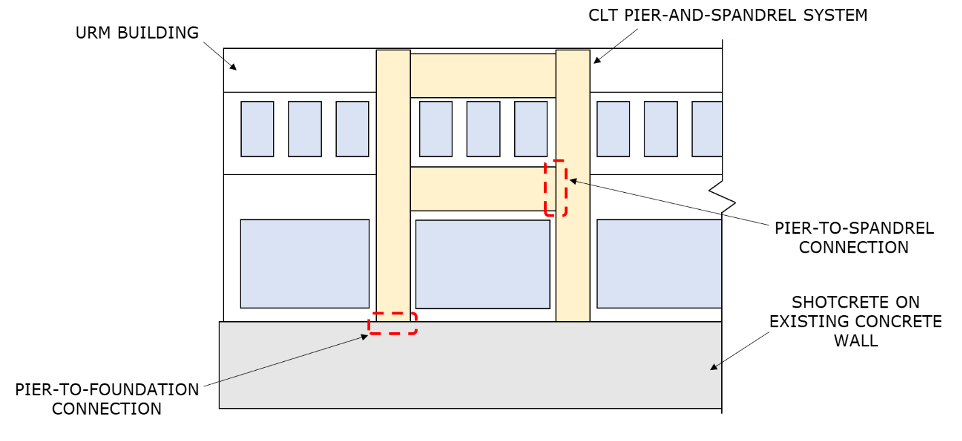Testing of a Cross-Laminated Timber Pier-and-Spandrel Seismic Retrofit Solution for Unreinforced Masonry Buildings
Research Team:
Andre R. Barbosa – Oregon State University (OSU), School of Civil and Construction Engineering
Graduate Research Assistants:
Renee Engleson – OSU, School of Civil and Construction Engineering
Rajendra Soti – OSU, School of Civil and Construction Engineering
Design Advisory Group: KPFF Consulting Engineers
Project Duration:
2018 – 2019
Facilities:
Oregon State University (OSU) Structural Engineering Research Laboratory
Introduction
Over the past several decades, thousands of unreinforced masonry (URM) buildings were constructed in the United States (US), many in highly seismic regions, such as the Pacific Northwest and California. URM bearing walls perform well when compressed under gravity loads, however, they are extremely weak when resisting lateral loads (e.g. earthquake loads). Because earthquake forces are bidirectional, URM walls experience both in-plane and out-of-plane loading. To combat the in-plane failure of URM walls, a cross-laminated timber (CLT) pier-and-spandrel seismic retrofit solution was developed and tested during this research project. CLT is an engineered wood product that consists of layers of laminated timber boards glued together so that each layer is oriented perpendicular to the adjacent layer(s). CLT is an attractive building material because it is renewable, promotes fast installation, and possesses a high strength-to-weight ratio.
Research Details
A cross-laminated timber (CLT) pier-and-spandrel system was designed to retrofit a historic URM building located in downtown Corvallis, Oregon. The pier-and-spandrel system consisted of 5-ply Spruce-Pine Fir (SPF) panels, yield-link moment connections, post-tensioned threaded rods, and steel shear-key plates. Due to size limitations, a 2/3-scale version of the system was built and tested at OSU. The system was constructed horizontally and erected using a bridge crane. The in-plane behavior of the pier-and-spandrel system was tested using a displacement-controlled quasi-static reverse-cyclic loading procedure.

Results and Resources
During the test, the pier-and-spandrel system exceeded the target drift of 1% and experienced a maximum drift of approximately 2%. The CLT panels did not experience any visible deformation during the test. Thus, the system design performance objectives (both level of deformation and loading) were met and the design solution shows promise for use in seismic retrofits.
Future Work:
Different methods of anchoring the pier-and-spandrel system to existing URM bearing walls need to be tested. Additionally, the out-of-plane performance and combined in-plane and out-of-plane loading of the system need to be tested.
Funding Acknowledgements:
Funding for this project was provided by the TallWood Design Institute (TDI) through a US Economic Development Administration (EDA) grant. This project was coordinated with the Downtown Corvallis Association (DCA) and Oregon Main Street Program through a grant awarded to Cascadia Seismic Strategies. Simpson Strong-Tie donated the majority of the steel plates and fasteners used.

